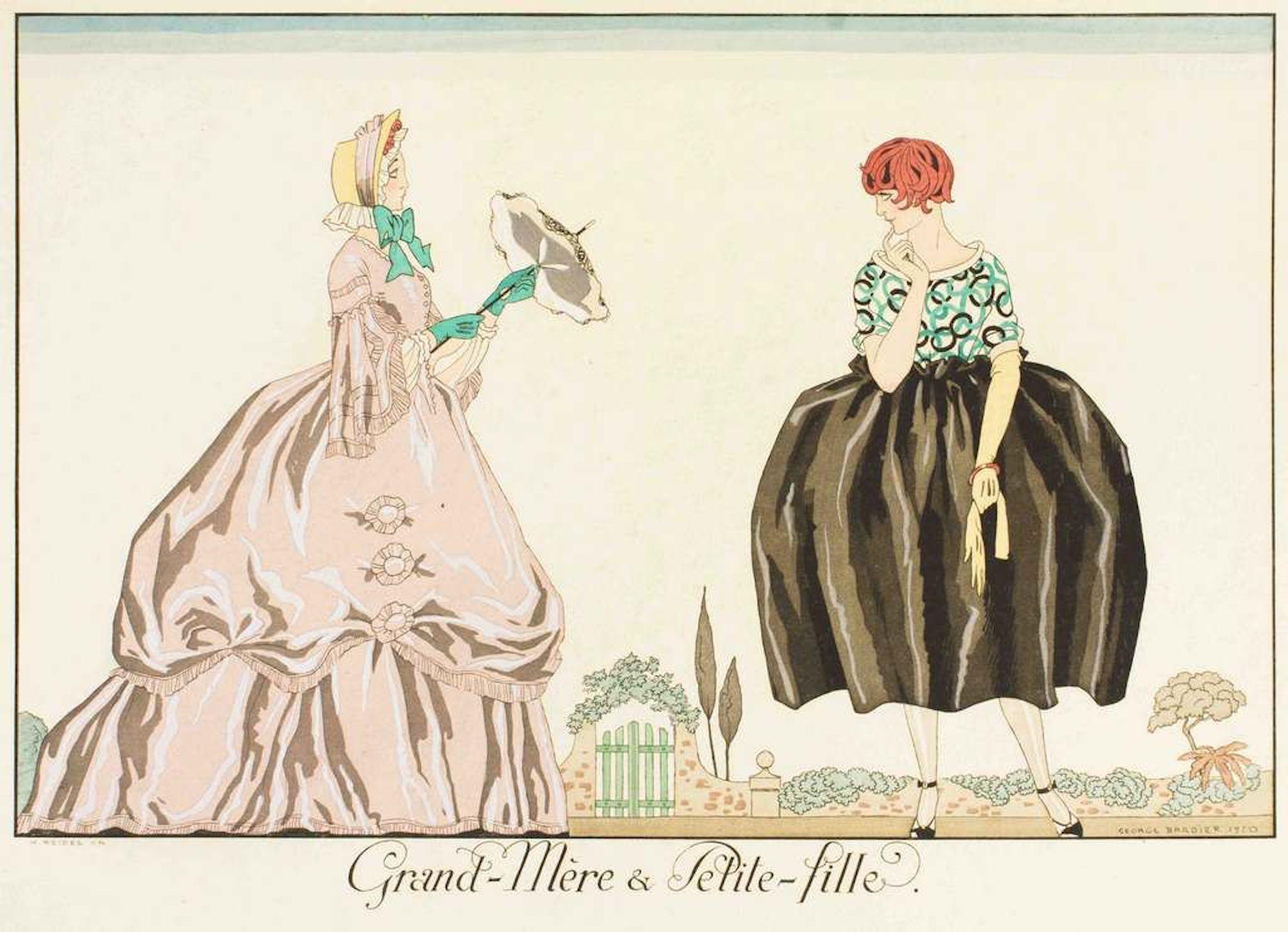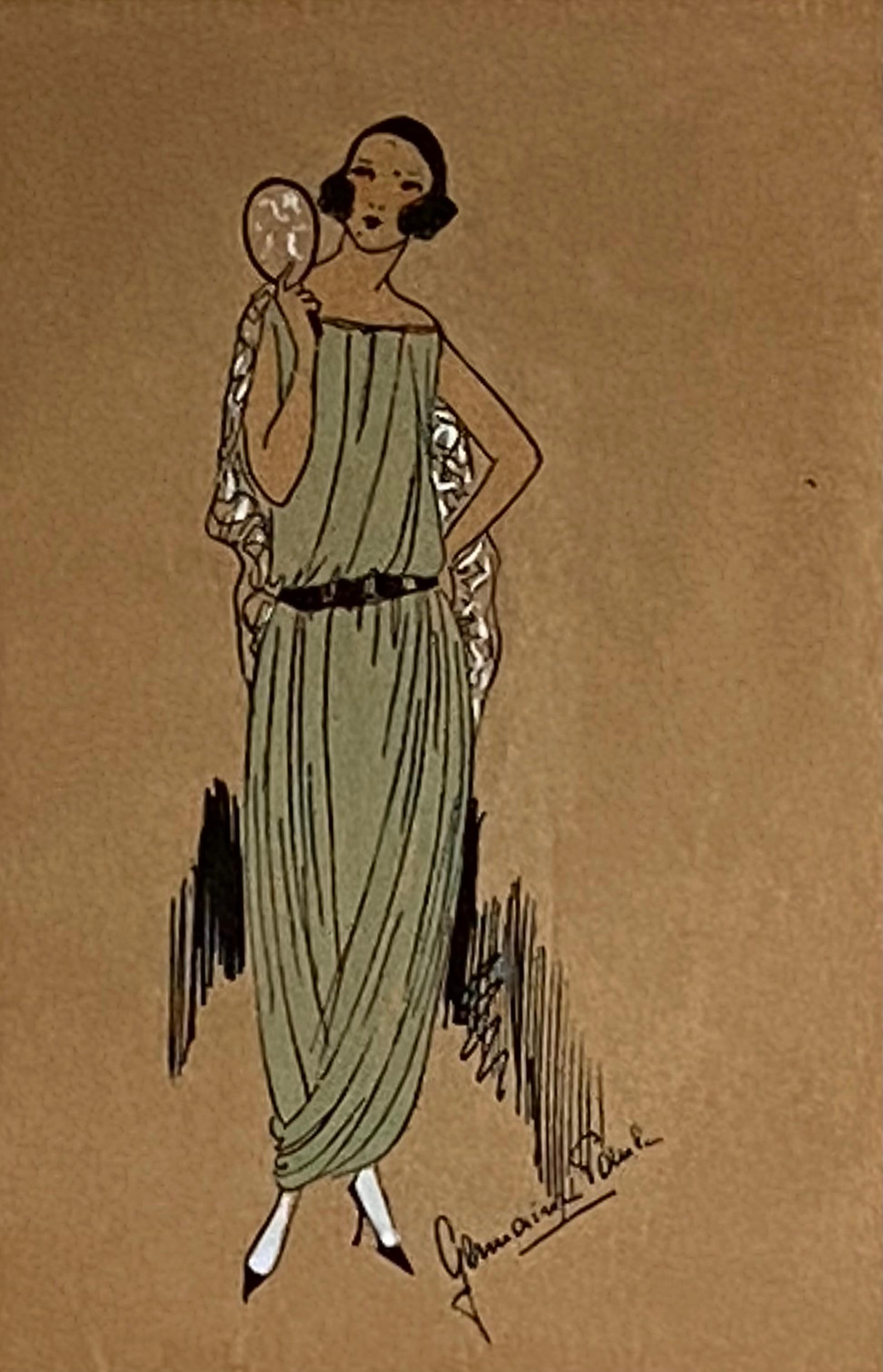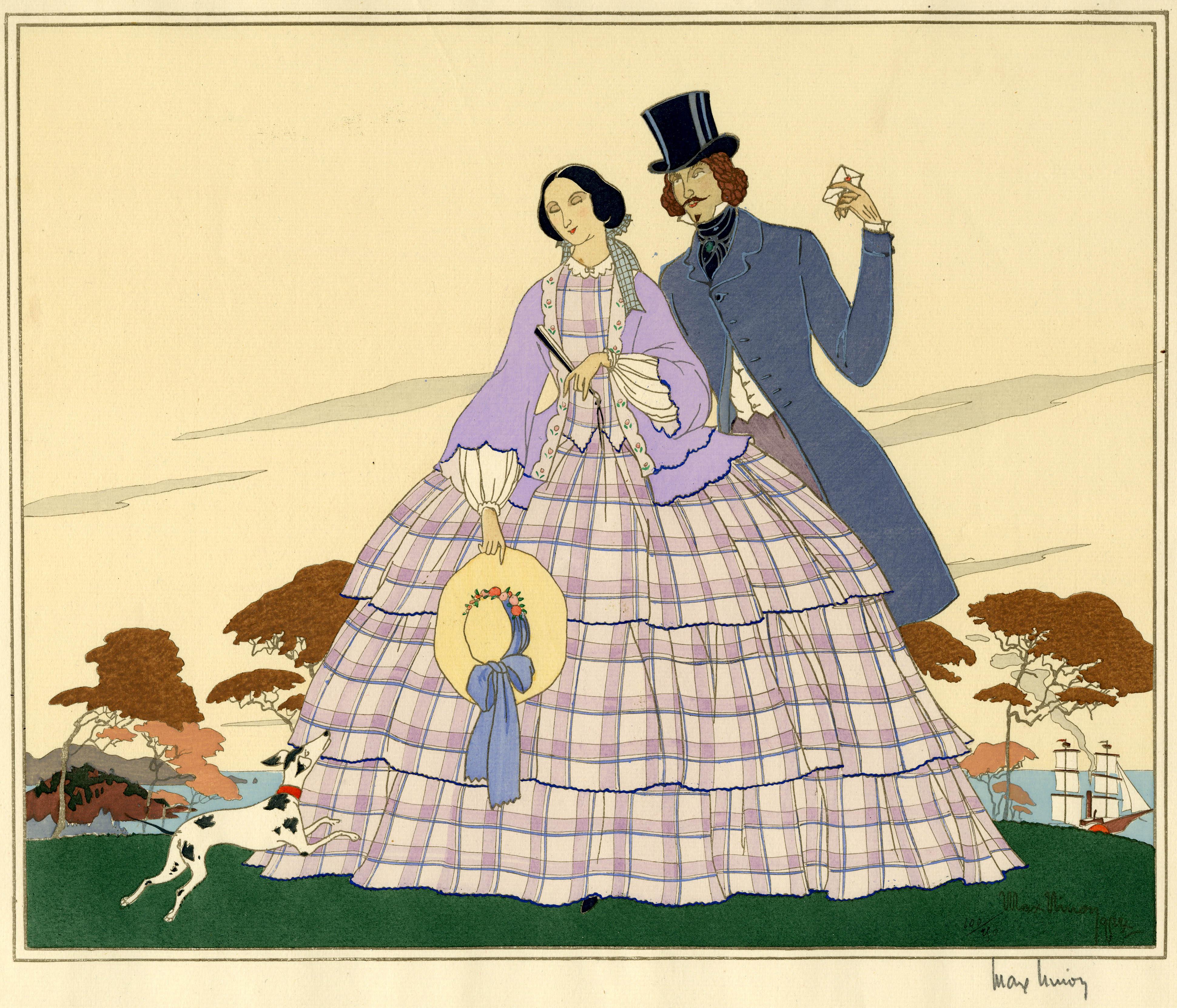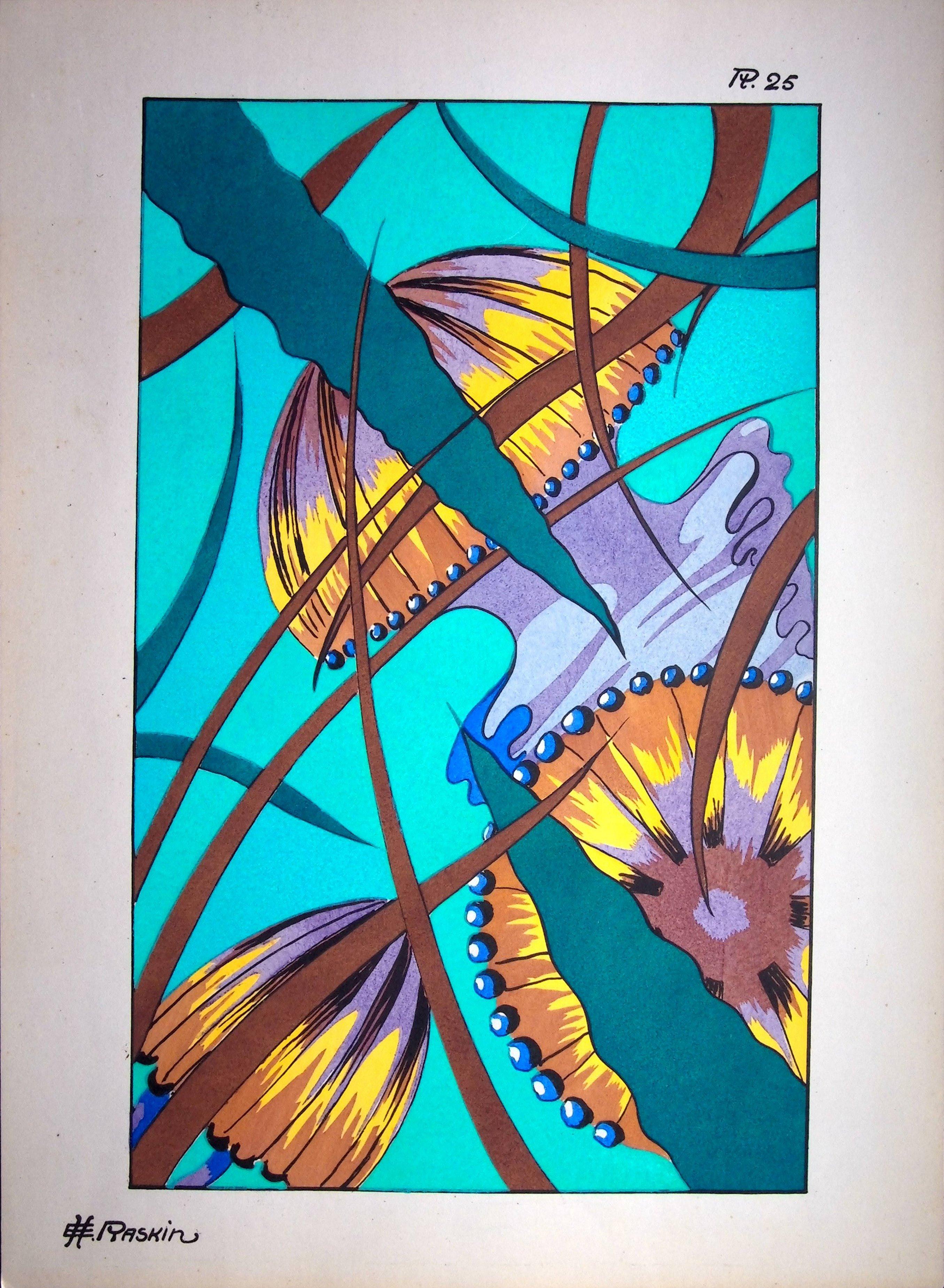Items Similar to Robe Grise
Want more images or videos?
Request additional images or videos from the seller
1 of 9
Victor Max NinonRobe Grise1923
1923
About the Item
Robe Grise
Pochoir (silk screen) printed in colors, 1923
Signed by the artist in pencil lower right (see photo)
The artist won a gold medal in Paris in 1925 for his pochoirs
Condition: Two spots in the upper left corner associated with the printing.
Victor Max Ninon (Vittorio Accornero de Testa, Italian, 1896-1982)
Biography
Vittorio Accornero de Testa was born in Casale Monferrato in 1896. He completed his first studies at the "Leardi" institute, but was forced to interrupt them due to the war events of the First World War . At 19 he was second lieutenant of the Alpine troops and in 1916 he took one of the first pilot's licenses. During the war he knows the bitterness of shooting down in air combat (for which he is decorated), but also the good fortune to stay alive, albeit with a disability. His art blossomed in the postwar period, first signing his works simply Ninon and then, probably at the suggestion of a French publisher, under the pseudonym of "Victor Max Ninon" (Victor and Max indicate strength and masculinity, Ninon boyhood) .In 1919 and 1924 he made illustrations for theGiornalino della Domenica , also together with his first wife Edina Altara , for Ardita and La Lettura . In 1923 he won the cover competition organized by the magazine El Hogar of Buenos Aires and in 1925 with his pochoirs he imposed himself in Paris at the international exhibition of modern decorative and industrial arts , obtaining a gold medal. In the same year he made two covers for the US magazine The Smart Set . In the 1920s he made numerous series of art deco style postcards for the Milanese publishing house Degami . On June 4, 1929, aGenoa embarks on the Conte Grande together with his wife Edina Altara , for New York . The two stayed in the American metropolis for a few months: in this period Accornero worked on the creation of theatrical sets and created some covers for Country Life magazine . Accornero gets awards and prizes, but the great economic crisis of the time and the nostalgia for Italy convince the two to return to their homeland, where they resume their activity as illustrators.
In 1934 Accornero moved to Milan, separated amicably from his wife and continued to dedicate himself to the illustration of children's books, abandoning the pseudonym Victor Max Ninon. It illustrates about 60 books, from the fables of Andersen , Perrault and Grimm , to the tales of Poe , as well as the famous Pinocchio and Cuore published by Mondadori, Mursia, Hoepli, Martello. Several books illustrated by Accornero have been published in French, Spanish, German and English. In addition to the periodicals already mentioned, he collaborates on the first edition of the Encyclopedia of Boys , Mondadori, and with the Italian magazines Lidel , Il Secolo XX, The Italian Illustration , Fantasies of Italy , The Woman , Cordelia , For You Lady , Grace , Metropolis , La Domenica del Corriere , The Corriere dei Piccoli .
In 1936 enters the world of cinema, creating sets and costumes for Wedding Vagabonde of Guido Brignone and The White Squadron of Augustus Genina . From 1935 to 1950 he also devoted himself to the theater, taking care of sets and costumes for numerous operettas, ballets and performances at the Scala in Milan and for the Milanese theaters Manzoni, Lirico and Olympia. Stages Marcello di Giordano, Nina pazza d'amore by Paisiello, I cantori di Nurimberga by Wagner, La Bohème by Puccini and other works. For this activity he is also cited in the Theater encyclopedia.
In the 1940s and 1950s he wrote and illustrated six books for children for Mondadori: Tomaso (1944), Giacomino (1949), Tomaso Cacciatore (1950), Zio Stefano (1950), In Campagna che delizia! (1953), Tomaso, dear Tomaso (1955). His illustrations of Perrault's Tales published in those years by Hoepli are famous.
His art in the fifties evolves towards hyperrealism . There are many personal exhibitions in Italy and abroad, including those at the Gallerie Gussoni (1959) and Bolzani (1963 and 1966) in Milan and Walcheturm (1962) in Zurich. Eminent critics praise his work, from Orio Vergani to Enrico Piceni, from Reto Roedel to De Chirico himself. On the Domenica del Corriere , the journalist, writer and painter Dino Buzzati wrote two pages on the Accornero exhibitions of 1959 [1] and 1963.
From 1960 to 1981 he collaborated with Gucci , designing about 80 foulards , including the very famous Flora, made in 1966 for Grace Kelly . A rich selection of these scarves was exhibited in Sassari in August 2009, in the premises of the Frumentaria, on the occasion of the exhibition "Giardini di Seta - Vittorio Accornero's scarves for Gucci".
He died in Milan in 1982.
Courtesy Wikipedia
- Creator:Victor Max Ninon (1896-1982, Italian)
- Creation Year:1923
- Dimensions:Height: 11.25 in (28.58 cm)Width: 12.625 in (32.07 cm)
- Medium:
- Movement & Style:
- Period:
- Condition:Note: two tiny spots upper left corner associated with the printing.
- Gallery Location:Fairlawn, OH
- Reference Number:
About the Seller
5.0
Recognized Seller
These prestigious sellers are industry leaders and represent the highest echelon for item quality and design.
Platinum Seller
These expertly vetted sellers are 1stDibs' most experienced sellers and are rated highest by our customers.
Established in 1978
1stDibs seller since 2013
716 sales on 1stDibs
Typical response time: 1 hour
Associations
International Fine Print Dealers Association
- ShippingRetrieving quote...Ships From: Fairlawn, OH
- Return PolicyA return for this item may be initiated within 10 days of delivery.
More From This SellerView All
- CoquetteBy Victor Max NinonLocated in Fairlawn, OHCoquette Pochoir (silk screen) printed in colors, c. 1923-1925 Signed by the artist in pencil lower right; numbered in ink on the image, (see photo) Edition: 250 (100/250) in pencil in image (see photo) Image size: 10-1/2 x 12-3/4" The artist won a gold medal in Paris in 1925 for his porchoirs Victor Max Ninon (Vittorio Accornero de Testa, Italian, 1896-1982) Biography Vittorio Accornero de Testa was born in Casale Monferrato in 1896. He completed his first studies at the "Leardi" institute, but was forced to interrupt them due to the war events of the First World War . At 19 he was second lieutenant of the Alpine troops and in 1916 he took one of the first pilot's licenses. During the war he knows the bitterness of shooting down in air combat (for which he is decorated), but also the good fortune to stay alive, albeit with a disability. His art blossomed in the postwar period, first signing his works simply Ninon and then, probably at the suggestion of a French publisher, under the pseudonym of "Victor Max Ninon" (Victor and Max indicate strength and masculinity, Ninon boyhood) .In 1919 and 1924 he made illustrations for theGiornalino della Domenica , also together with his first wife Edina Altara , for Ardita and La Lettura . In 1923 he won the cover competition organized by the magazine El Hogar of Buenos Aires and in 1925 with his pochoirs he imposed himself in Paris at the international exhibition of modern decorative and industrial arts , obtaining a gold medal. In the same year he made two covers for the US magazine The Smart Set . In the 1920s he made numerous series of art deco style postcards for the Milanese publishing house Degami . On June 4, 1929, aGenoa embarks on the Conte Grande together with his wife Edina Altara , for New York . The two stayed in the American metropolis for a few months: in this period Accornero worked on the creation of theatrical sets and created some covers for Country Life magazine . Accornero gets awards and prizes, but the great economic crisis of the time and the nostalgia for Italy convince the two to return to their homeland, where they resume their activity as illustrators. In 1934 Accornero moved to Milan, separated amicably from his wife and continued to dedicate himself to the illustration of children's books, abandoning the pseudonym Victor Max Ninon. It illustrates about 60 books, from the fables of Andersen , Perrault and Grimm , to the tales of Poe , as well as the famous Pinocchio and Cuore published by Mondadori, Mursia, Hoepli, Martello. Several books illustrated by Accornero have been published in French, Spanish, German and English. In addition to the periodicals already mentioned, he collaborates on the first edition of the Encyclopedia of Boys , Mondadori, and with the Italian magazines Lidel , Il Secolo XX, The Italian Illustration , Fantasies of Italy , The Woman , Cordelia , For You Lady , Grace , Metropolis , La Domenica del Corriere , The Corriere dei Piccoli . In 1936 enters the world of cinema, creating sets and costumes for Wedding Vagabonde of Guido Brignone and The White Squadron of Augustus Genina . From 1935 to 1950 he also devoted himself to the theater, taking care of sets and costumes for numerous operettas, ballets and performances at the Scala in Milan and for the Milanese theaters Manzoni, Lirico and Olympia. Stages Marcello di Giordano, Nina pazza d'amore by Paisiello, I cantori di Nurimberga by Wagner, La Bohème by Puccini and other works. For this activity he is also cited in the Theater encyclopedia. In the 1940s and 1950s he wrote and illustrated six books for children for Mondadori: Tomaso (1944), Giacomino (1949), Tomaso Cacciatore (1950), Zio Stefano (1950), In Campagna che delizia! (1953), Tomaso, dear Tomaso (1955). His illustrations of Perrault's Tales published in those years by Hoepli are famous. His art in the fifties evolves towards hyperrealism . There are many personal exhibitions in Italy and abroad, including those at the Gallerie Gussoni (1959) and Bolzani (1963 and 1966) in Milan and Walcheturm (1962) in Zurich. Eminent critics praise his work, from Orio Vergani to Enrico Piceni, from Reto Roedel to De Chirico himself. On the Domenica del Corriere , the journalist, writer and painter Dino Buzzati...Category
1920s Art Deco Figurative Prints
MaterialsStencil
- En EspagneBy Victor Max NinonLocated in Fairlawn, OHEn Espagne Pochoir (silk screen) printed in colors Signed by the artist in pencil lower right The artist won a gold medal in Paris in 1925 for his pochoirs Condition: Excellent Image size: 11-1/2 x 13" Sheet size: 19 1/2 x 24 3/4"; The artist won a gold medal in Paris in 1925 for his porchoirs The artist is Italian, Vittorio Accornero de Testa, working in Paris. The image combines Art Deco and Japonism, two of the most famous styles of the period of the 1920's. Biography Vittorio Accornero de Testa was born in Casale Monferrato in 1896. He completed his first studies at the "Leardi" institute, but was forced to interrupt them due to the war events of the First World War . At 19 he was second lieutenant of the Alpine troops and in 1916 he took one of the first pilot's licenses. During the war he knows the bitterness of shooting down in air combat (for which he is decorated), but also the good fortune to stay alive, albeit with a disability. His art blossomed in the postwar period, first signing his works simply Ninon and then, probably at the suggestion of a French publisher, under the pseudonym of "Victor Max Ninon" (Victor and Max indicate strength and masculinity, Ninon boyhood) .In 1919 and 1924 he made illustrations for theGiornalino della Domenica , also together with his first wife Edina Altara , for Ardita and La Lettura . In 1923 he won the cover competition organized by the magazine El Hogar of Buenos Aires and in 1925 with his pochoirs he imposed himself in Paris at the international exhibition of modern decorative and industrial arts , obtaining a gold medal. In the same year he made two covers for the US magazine The Smart Set . In the 1920s he made numerous series of art deco style postcards for the Milanese publishing house Degami . On June 4, 1929, aGenoa embarks on the Conte Grande together with his wife Edina Altara , for New York . The two stayed in the American metropolis for a few months: in this period Accornero worked on the creation of theatrical sets and created some covers for Country Life magazine . Accornero gets awards and prizes, but the great economic crisis of the time and the nostalgia for Italy convince the two to return to their homeland, where they resume their activity as illustrators. In 1934 Accornero moved to Milan, separated amicably from his wife and continued to dedicate himself to the illustration of children's books, abandoning the pseudonym Victor Max Ninon. It illustrates about 60 books, from the fables of Andersen , Perrault and Grimm , to the tales of Poe , as well as the famous Pinocchio and Cuore published by Mondadori, Mursia, Hoepli, Martello. Several books illustrated by Accornero have been published in French, Spanish, German and English. In addition to the periodicals already mentioned, he collaborates on the first edition of the Encyclopedia of Boys , Mondadori, and with the Italian magazines Lidel , Il Secolo XX, The Italian Illustration , Fantasies of Italy , The Woman , Cordelia , For You Lady , Grace , Metropolis , La Domenica del Corriere , The Corriere dei Piccoli . In 1936 enters the world of cinema, creating sets and costumes for Wedding Vagabonde of Guido Brignone and The White Squadron of Augustus Genina . From 1935 to 1950 he also devoted himself to the theater, taking care of sets and costumes for numerous operettas, ballets and performances at the Scala in Milan and for the Milanese theaters Manzoni, Lirico and Olympia. Stages Marcello di Giordano, Nina pazza d'amore by Paisiello, I cantori di Nurimberga by Wagner, La Bohème by Puccini and other works. For this activity he is also cited in the Theater encyclopedia. In the 1940s and 1950s he wrote and illustrated six books for children for Mondadori: Tomaso (1944), Giacomino (1949), Tomaso Cacciatore (1950), Zio Stefano (1950), In Campagna che delizia! (1953), Tomaso, dear Tomaso (1955). His illustrations of Perrault's Tales published in those years by Hoepli are famous. His art in the fifties evolves towards hyperrealism . There are many personal exhibitions in Italy and abroad, including those at the Gallerie Gussoni (1959) and Bolzani (1963 and 1966) in Milan and Walcheturm (1962) in Zurich. Eminent critics praise his work, from Orio Vergani to Enrico Piceni, from Reto Roedel to De Chirico himself. On the Domenica del Corriere , the journalist, writer and painter Dino Buzzati...Category
1920s Art Deco Figurative Prints
MaterialsScreen
- Au JaponBy Victor Max NinonLocated in Fairlawn, OHAu Japon Pochoir (Stencil Print), 1925 Signed by the artist in pencil lower right (see photo) Signed in the image lower left (see photo) Stamped verso: Made in France Note: The artist won a gold medal in Paris in 1925 for his porchoirs Condition: excellent Image size: 11 1/2 x 13 inches Sheet size: 20 x 25 3/4 inches The artist is Italian, Vittorio Accornero de Testa, working in Paris. The image combines Art Deco and Japonism, two of the most famous styles of the period of the 1920's. Condition: Excellent, never matted or framed Victor Max Ninon (Vittorio Accornero de Testa, Italian, 1896-1982) Biography Vittorio Accornero de Testa was born in Casale Monferrato in 1896. He completed his first studies at the "Leardi" institute, but was forced to interrupt them due to the war events of the First World War . At 19 he was second lieutenant of the Alpine troops and in 1916 he took one of the first pilot's licenses. During the war he knows the bitterness of shooting down in air combat (for which he is decorated), but also the good fortune to stay alive, albeit with a disability. His art blossomed in the postwar period, first signing his works simply Ninon and then, probably at the suggestion of a French publisher, under the pseudonym of "Victor Max Ninon" (Victor and Max indicate strength and masculinity, Ninon boyhood) .In 1919 and 1924 he made illustrations for theGiornalino della Domenica , also together with his first wife Edina Altara , for Ardita and La Lettura . In 1923 he won the cover competition organized by the magazine El Hogar of Buenos Aires and in 1925 with his pochoirs he imposed himself in Paris at the international exhibition of modern decorative and industrial arts , obtaining a gold medal. In the same year he made two covers for the US magazine The Smart Set . In the 1920s he made numerous series of art deco style postcards for the Milanese publishing house Degami . On June 4, 1929, aGenoa embarks on the Conte Grande together with his wife Edina Altara , for New York . The two stayed in the American metropolis for a few months: in this period Accornero worked on the creation of theatrical sets and created some covers for Country Life magazine . Accornero gets awards and prizes, but the great economic crisis of the time and the nostalgia for Italy convince the two to return to their homeland, where they resume their activity as illustrators. In 1934 Accornero moved to Milan, separated amicably from his wife and continued to dedicate himself to the illustration of children's books, abandoning the pseudonym Victor Max Ninon. It illustrates about 60 books, from the fables of Andersen , Perrault and Grimm , to the tales of Poe , as well as the famous Pinocchio and Cuore published by Mondadori, Mursia, Hoepli, Martello. Several books illustrated by Accornero have been published in French, Spanish, German and English. In addition to the periodicals already mentioned, he collaborates on the first edition of the Encyclopedia of Boys , Mondadori, and with the Italian magazines Lidel , Il Secolo XX, The Italian Illustration , Fantasies of Italy , The Woman , Cordelia , For You Lady , Grace , Metropolis , La Domenica del Corriere , The Corriere dei Piccoli . In 1936 enters the world of cinema, creating sets and costumes for Wedding Vagabonde of Guido Brignone and The White Squadron of Augustus Genina . From 1935 to 1950 he also devoted himself to the theater, taking care of sets and costumes for numerous operettas, ballets and performances at the Scala in Milan and for the Milanese theaters Manzoni, Lirico and Olympia. Stages Marcello di Giordano, Nina pazza d'amore by Paisiello, I cantori di Nurimberga by Wagner, La Bohème by Puccini and other works. For this activity he is also cited in the Theater encyclopedia. In the 1940s and 1950s he wrote and illustrated six books for children for Mondadori: Tomaso (1944), Giacomino (1949), Tomaso Cacciatore (1950), Zio Stefano (1950), In Campagna che delizia! (1953), Tomaso, dear Tomaso (1955). His illustrations of Perrault's Tales published in those years by Hoepli are famous. His art in the fifties evolves towards hyperrealism . There are many personal exhibitions in Italy and abroad, including those at the Gallerie Gussoni (1959) and Bolzani (1963 and 1966) in Milan and Walcheturm (1962) in Zurich. Eminent critics praise his work, from Orio Vergani to Enrico Piceni, from Reto Roedel to De Chirico himself. On the Domenica del Corriere , the journalist, writer and painter Dino Buzzati...Category
1920s Art Deco Figurative Prints
MaterialsScreen
- Franky and Johnny in ParisBy Adolf DehnLocated in Fairlawn, OHSigned, dated, and editioned in pencil by the artist Edition:30, plus trial proofs; this print numbered 23/30 Printed by Edmond Desjobert, Paris Provenance: Estate of the artist The image is loosely based on the tragic love story of Frankie and Johnny, memorialized in Jazz, Blue, Country, Rock a Billy and Motown. At least 256 recordings of "Frankie and Johnny" have been made since the early 20th century. Inspired by a traditional song first recorded by The Leighton Brothers in 1912. Among the artist who have recorded the varying versions of the song are Gene Autrey (1929), Jimmie Rodgers (1929), Lead Belly (1939), Lena Horne (1946), Les Paul and Mary Ford (1952), Sammy Davis Jr. (1956), Pete Seeger...Category
1920s Art Deco Figurative Prints
MaterialsLithograph
- Lingering Snow Mount YoshinoBy Utagawa KuniyoshiLocated in Fairlawn, OHLingering Snow Mount Yoshino (Shidzuka-gozen toiling through snow after her last farewell to Yoshitsune) Signed: Ichiyusai Kuniyoshi ga Censor seal: Tanaka Series: Kenjo hakkei ...Category
1840s Figurative Prints
MaterialsWoodcut
- Les Pauvres (The Poor), from the famous Blue PeriodBy Pablo PicassoLocated in Fairlawn, OHLes Pauvres (The Poor) Created during the artist's famous "Blue Period" Etching on Van Gelder Zonen paper, 1905 From: "La Suite de Saltimbanques" (Acrobats) [...Category
Early 1900s French School Figurative Prints
MaterialsEtching
You May Also Like
- Grand-mere et Petite-fille - Pochoir by G. Barbier - 1920By George BarbierLocated in Roma, ITThis pochoir belongs to the portfolio 'Le Bonheur du Jour', by George Barbier. A very fine work of one of the most important and famous european illustrators of Art Deco, whose infl...Category
1920s Art Deco Figurative Prints
MaterialsStencil
- L'apres-midi d'un Faune - Pochoir by G. Barbier - 1920By George BarbierLocated in Roma, ITThis is one of the artworks in the portfolio 'Le Bonheur du Jour', by George Barbier. A very fine work of one of the most important and famous european illustrators of Art Deco, who...Category
1920s Art Deco Figurative Prints
MaterialsStencil
- “Sylvia”Located in Southampton, NYOriginal fashion illustration for Tres Parisien, December, 1921 Moroccan Crepe Dress by Germaine-Paule Joumard, Fashion Art Deco Pochoir on Chinese Paper. Artwork size is 7.5 by 5 i...Category
1920s Art Deco Figurative Prints
MaterialsArchival Paper, Stencil
- Frontispiece for Le Bonheur du Jour - Pochoir by G. Barbier - 1929By George BarbierLocated in Roma, ITLe Bonheur du Jour by George Barbie (Nantes, 1889 - Paris, 1932) is an artwork realized in 1929. Original colored pochoir on cardboard. Perfect conditions. Le Bonheur du Jour is...Category
1920s Art Deco Figurative Prints
MaterialsStencil
- Scyphozoan Jellyfish, 1926 - Original LithographLocated in Paris, FRE.H. Raskin Scyphozoan Jellyfish Original lithograph and stencil Printed signature in the plate On paper, 37,5 x 27,5 cm (c. 14,7 x 10,8 inch) INFORMATION : This lithograph is part...Category
1920s Art Deco Figurative Prints
MaterialsStencil, Lithograph
- 'Variations, 10' — 1920s French Art Deco PochoirBy Edouard BenedictusLocated in Myrtle Beach, SCEdouard Benedictus, 'Variations, plate 10' from the portfolio 'Variations Quatre-Vingt-Six Motifs Décoratifs en Vingt Planches', color pochoir, edition not stated, 1923. Signed in the matrix, in the left bottom margin. A superb, painterly impression, with fresh, vivid colors and metallic silver, on heavy, cream wove paper with margins (1 to 1 3/4 inches). A repaired tear in the center left margin, not affecting the image, in good condition. Archivally sleeved, unmatted. Image size 14 3/8 x 11 9/16 inches; sheet size 17 3/8 x 13 7/8 inches. The pochoir production is by Jean Saudé, the French printmaker known for his mastery of the technique and the author of the first how-to book on the pochoir process. Published by Éditions Albert Levy, Librairie Centrale des Beaux-Arts, Paris. Collections: Metropolitan Museum of Art, Minneapolis Institute of Art, New York Public Library, Victoria and Albert Museum. Additional works from this suite of vibrant Art Deco floral designs are available from Keith Sheridan LLC...Category
1920s Art Deco Figurative Prints
MaterialsStencil
Recently Viewed
View AllMore Ways To Browse
Antique Life Magazines
Antique Robe
Gold Robe
French Robe
Art Deco Theater
Italy Robe
Antique Childrens Books
Robe Set
1950s American Magazine Illustrations
Wagner Germany
Gucci 1981
Art Deco Magazine Covers
Kelly 19
Art Deco Ballet
Art Deco Costume Design
Art Deco Style Screen
Antique Silk Robe
Dior Lady Dior White





